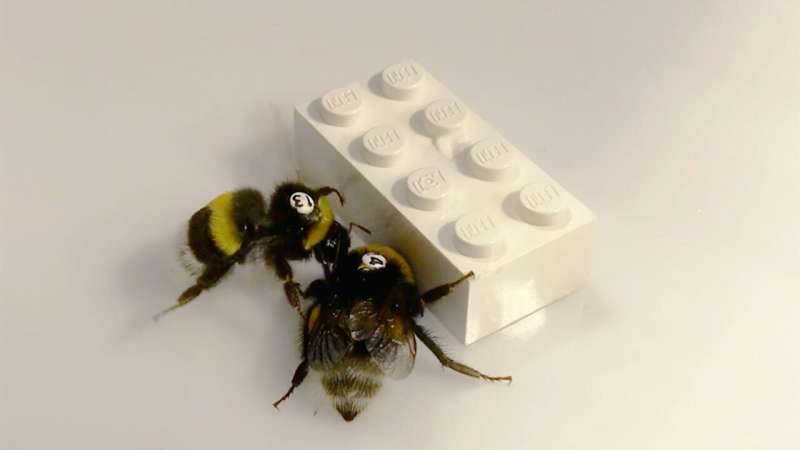This article has been reviewed according to Science X's editorial process and policies. Editors have highlighted the following attributes while ensuring the content's credibility:
fact-checked
peer-reviewed publication
trusted source
proofread
Lego-pushing bumblebees reveal insect collaboration dynamics

A new study reveals that cooperation by bumblebees isn't simply a result of accumulated individual efforts. Rather, these miniature-brained creatures are not just hard-working pollinators, but also show signs of being master collaborators.
The study, conducted at the University of Oulu in Finland and published in the Proceedings of the Royal Society B, demonstrates the role of teamwork for bumblebees in novel cooperative challenges.
It has previously been thought that understanding the role of a partner in a cooperative task is a complex phenomenon that is mainly characteristic of big-brained mammals such as humans and chimpanzees. But new research shows that even insects can learn and adapt to cooperative tasks. Understanding how collaboration has become so important for humans requires comparisons with other species.
"The study's findings challenge conventional notions of insects, and the ability to work together towards a common goal is present even in the miniature brain of bumblebees," says lead researcher, Associate Professor, Dr. Olli Loukola.
In the study, pairs of bumblebees were trained in two different cooperative tasks. Bees learned to simultaneously push a Lego block in the middle of an arena, or to simultaneously push a door at the end of a transparent double tunnel to gain access to rewarding nectar.
Bumblebees' behaviors suggest their efforts towards solving the cooperative tasks were influenced by the presence, absence, and movement direction of their partner. When their partner was delayed, bees tended to take longer than controls to initiate pushing and were more likely to push only when their partner pushed with them.
In short, bees trained on cooperative tasks seemed to wait for their partner. The bumblebees in the control group, which had been trained alone, did not show similar behavior.
In the tunnel task, if their partner was delayed, partnered bees were also much more likely than controls to turn around before they first reached the door and to turn around again back towards the door when they saw their partner heading in the right direction.
Dr. Loukola says, "Our findings show for the first time that bumblebees can learn to solve novel cooperative tasks outside the hive. But the coolest part of this work is that it clearly demonstrates that bumblebee cooperation is socially influenced, and not just driven by individual efforts."
Bees' turning behaviors hint at the possibility that they are intentionally working with each other to facilitate cooperation. However, Dr. Loukola warns, "Whether bumblebees truly understand the role of their partner will require further research with more detailed monitoring of their behavior during cooperation."
"This research can contribute to a broader understanding of animal behavior and evolution. It may also inspire new research on the evolution of social intelligence and cooperation in different animal species, as well as applications in areas such as technology, robotics and medicine. A better understanding of the complex behavior and abilities of animals can increase interest in environmental protection and animal welfare," concludes Loukola.
More information: Olli J. Loukola et al, Evidence for socially influenced and potentially actively coordinated cooperation by bumblebees, Proceedings of the Royal Society B: Biological Sciences (2024). DOI: 10.1098/rspb.2024.0055
Journal information: Proceedings of the Royal Society B
Provided by University of Oulu

















